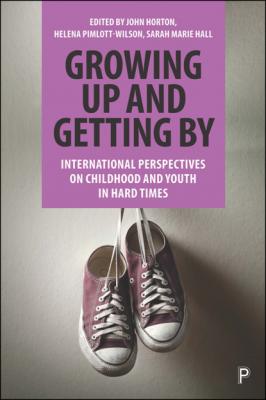Growing Up and Getting By. Группа авторов
Читать онлайн.| Название | Growing Up and Getting By |
|---|---|
| Автор произведения | Группа авторов |
| Жанр | География |
| Серия | |
| Издательство | География |
| Год выпуска | 0 |
| isbn | 9781447352945 |
Conclusion
Educational marketisation is a significant part of Swedish society and is often taken for granted, especially in metropolitan regions such as Stockholm. This also means that the educational market is constantly changing and developing, and that there are continuous hierarchical struggles between schools. As new schools emerge, others change direction, re-locate, upscale, downsize or in some cases become obsolete. In this context, students and parents/guardians orientate between the different options and possibilities. They visit open houses and school fairs, gather information, consult friends, read webpages and are approached with marketing pamphlets containing a diverse array of promises. The latter might include offers to go abroad during the school year, gifts and prospects which have little to do with formal education. Prestigious schools often do the opposite and maintain a low-key profile with little explicit promotion. To navigate the educational market, students deploy various sets of strategies. These strategies are not rationally intentional (Bourdieu, 1990), rather class-based and governed by social factors such as familiarity, networks and lifestyle preferences. Schools on the other hand deploy strategies to attract students. This is done to keep up with competitors and avoid financial struggles. Except for the immediate marketing, schools compete by the means of institutional assets. Such assets include student group composition, respected teachers, specific educational programmes and successful alumni. Additionally, institutional assets could be related to the geography of the school. That is to say, where the school is situated, the history of the school and the architectural outline of the building.
This chapter has explored the phenomenon of post-16 inner-city schools. More specifically, how the uneven geography of the Stockholm region affects the strategies deployed by schools and students. The main theme has been related to the gentrified and wealthier inner-city of Stockholm and how it is used as a symbolic asset in the competition between schools. Our analysis shows that there are several hierarchies to account for. First of all, the socio-symbolic (Wacquant, 2015) boundaries that separates geographical regions and provides relational advantages for schools located in wealthier areas. Thus, schools placed in the inner-city profit from the locational setting. This is one significant reason for the growing number of inner-city schools since 1992. The same goes for the increasing number of students attending inner-city schools.
Besides the possibilities of public transport, inner-city schools profit from the proximity to a range of characteristics. Similar to what students argue, the city centre of Stockholm is portrayed as a melting-pot. Students see it as a place to meet, exchange ideas and consume. This is also why post-16 schools use the assets of geographical proximity as a comparative advantage (Larsson and Hultqvist, 2017). Some recent independent schools promote the vibrant city as an option with lots to offer while prestigious elite schools rely more heavily on culture and history. Simultaneously, school buildings and architecture also become important assets to attract potential students. Here, some older elite schools benefit by having history on their side. They can profit from a recognised legacy and stories that relate the school building to a history of education. More recent schools are forced to emulate a similar history to secure legitimacy. With the support of other institutional assets, some elite, independent schools have been able to do so with success. Others have not received the same amount of recognition. Most of the contemporary independent schools, however, are not able to obtain spacious and historical buildings. Instead, they are situated in regular office or residential buildings. Still, these schools profit from the location in the city and maintain a better position than they would elsewhere.
Yet, as we have shown in this chapter, there are also hierarchies among the post-16 inner-city schools. The term ‘inner-city school’ is socially and historically constituted and related to the circuit of post-16 elite schools. This means that not all schools are recognised or considered to be inner-city schools in spite of their placement in the city. For students attending schools within the elite circuit, the term ‘inner-city school’ indicates more than a geographical location and entails specific distinctive properties. Mostly these are related to the social, historical and academic foundation of the schools. As discussed earlier, the low-key profile of post-16 elite schools also means that they attract specific groups of students, often with higher levels of cultural capital. These students are aware of the hierarchies among the various post-16 schools in Stockholm and follow the norms created within the family, secondary school and among friends.
To conclude, the title inner-city school needs to be contextualised and related to the dynamics of the city. Furthermore, as shown in this chapter, it also needs to be discussed in relation to the hierarchies that exists among schools. When a city changes, so do the strategies of schools and students. For young people, these changes can be hard to evaluate which leads to some or them being marginalised by the system.
Notes
1 https://fakta.academedia.se/kortfakta/
2By the late 1980s it was calculated that only 0.2% of students attended privately managed schools (Blomqvist, 2004: 142).
3Swedish students both apply for schools and programmes. Different schools might have different programmes. However, the majority offer the natural or social science programmes.
4In this chapter we have choosen to use the term ‘assets’ instead of ‘capitals’. For discussion see Savage, Warde and Devine (2005).
5All the photos in this chapter are by Staffan Larsson.
6 https://www.folkuniversitetet.se/Skolor/gymnasieskolor/Kungstensgymnasiet/Om-KSG/
7 https://www.tillskararakademin.com/gymnasiet/om-skolan/
